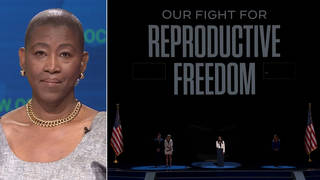
We speak with Harvard journalism analyst Laura Hazard Owen, who says reporters will have to abandon “conventional journalism wisdom” to cover abortion stories following the overturning of Roe v. Wade. “Reporters are going to need to accept that it’s going to be really hard to sort of do the things that they’ve been trained to do when they’re writing about these cases,” says Hazard Owen, explaining why privacy laws and the criminalization of doctors will make it harder to identify pregnant people and fact-check different abortion stories that involve young victims or occur in Republican-controlled states. Her latest piece is titled “Unimaginable abortion stories will become more common. Is American journalism ready?”
Transcript
AMY GOODMAN: This is Democracy Now!, democracynow.org, The War and Peace Report. I’m Amy Goodman. A warning: This next segment deals with the topic of sexual assault. I’m Amy Goodman.
Roughly a dozen Republican-led states have moved to ban nearly all abortion since late June, when the U.S. Supreme Court overturned Roe v. Wade, which had legalized abortion nationwide since 1973, almost 50 years ago. More states are expected to enact more bans soon.
As these laws take effect, shocking cases are surfacing, such as the 10-year-old Ohio girl who became pregnant after she was raped, had to travel to Indiana to get abortion care because she was three days past Ohio’s six-week limit, which doesn’t include exceptions for rape or incest. At first, anti-choice legislators and the Ohio attorney general denied any of it was true. Then, when a man was arrested who admitted to raping the 10-year-old at least twice, they moved on to attack the OB/GYN who had helped her get an abortion. Indiana’s Republican Attorney General Todd Rokita said he was investigating whether or not the provider reported the rape to the state. Turns out she had in fact done so, in accordance with state law, and she wrote a letter to him, a cease-and-desist letter, so he stopped threatening her for the moment.
Abortion access workers say the new state-level anti-abortion laws threaten the ability of abortion providers to assist child rape and incest survivors. Prism reporter Tina Vasquez said such services are commonly sought, tweeting, “This morning I interviewed a person who does abortion access work in the Midwest. I asked about the story of the 10 year old rape victim in Ohio who had to travel to Indiana for abortion care. The worker said they have helped two 11 year olds access care this week,” she said.
Meanwhile, a colleague of Indiana doctor Caitlin Bernard, who assisted the 10-year-old in getting an abortion, wrote an op-ed in The New York Times about threats Dr. Bernard has since faced. Dr. Tracey Wilkinson, an assistant professor of pediatrics at Indiana University School of Medicine, wrote, quote, “The attacks on her were instantaneous and fierce. Multiple state attorneys general and high-profile conservatives suggested that Dr. Bernard was a liar. Pundits questioned her integrity, and articles in numerous news outlets cast doubt on the story, with The Wall Street Journal editorial board declaring it a 'fanciful tale' that was 'too good to confirm.'”
Dr. Wilkinson continued, “This moment, post-Roe v. Wade, feels particularly frightening and is chilling to anyone who cares for patients, especially anyone providing reproductive health care. This saga has had real-world repercussions for Dr. Bernard. The local police have been alerted to concerns for her physical safety,” unquote.
This comes as House lawmakers voted mostly along party lines to pass two abortion bills Friday, including one that would safeguard the right to travel across state lines to get an abortion. This is California Democrat Judy Chu.
REP. JUDY CHU: Make no mistake: If Republicans had their way, this would be a country of forced birth. They’ve already openly discussed a national abortion ban. When asked about that pregnant 10-year-old, the anti-abortion lawyer said that this child would one day see the benefit of being forced to carry her rapist’s baby. Can you imagine? They think it’s OK that the 10-year-old is raped, as long as she produces a baby. That’s why we need to pass the Women’s Health Protection Act, because every person, no matter what the circumstances, no matter how they become pregnant, deserves dignity, safety and care in seeking an abortion.
AMY GOODMAN: For more, we’re joined by Laura Hazard Owen. She is the editor of the Nieman Journalism Lab at Harvard University, where her new piece is headlined “Unimaginable abortion stories will become more common. Is American journalism ready?”
Laura, welcome to Democracy Now! What do you mean?
LAURA HAZARD OWEN: Thanks so much for having me.
I wrote that story after a fact-check appeared in The Washington Post. Basically, this was before it had been — it had come out that the story was true. And —
AMY GOODMAN: About the 10-year old girl getting an abortion in Indiana.
LAURA HAZARD OWEN: Yes, the fact that — yes. And so, this was when Biden had cited the story, the report, in a speech that he gave accompanying an executive action that he was giving on to sort of help people access abortion. And he mentioned the case, and The Washington Post — a columnist there picked it up and basically tried to fact-check the story, saying, “Could this really happen?” And because, for example, the doctor, Dr. Bernard, would not do things like confirm the location of the child or whether a police report had been filed, he basically said it wasn’t really possible to confirm if this had happened. He also said that rape and pregnancy of 10-year-olds is rare, at a time when about one, like, under-15-year-old a week in Ohio was getting an abortion. So, it is not rare.
AMY GOODMAN: I wanted to turn to an interview with the attorney for Dr. Caitlin Bernard. This is Kathleen DeLaney, who appeared on CNN last week.
KATHLEEN DELANEY: First, we want Mr. Rokita to stop lying about Dr. Bernard and stop smearing her reputation and making ridiculously unsupported accusations, when even the barest minimum of homework on his part would have found that that report had been timely done. So we want him to stop the smear. And then we want him to stop this dangerous rhetoric that he’s using, where he is whipping people up into a frenzy at a very unsettled time in our nation’s history. And we want to make sure that our client stays safe.
AMY GOODMAN: So, if you can talk about this? We’re talking about the doctor worrying about her own safety. And, of course, there’s the children. You have Tina Vasquez, Prism, talking about talking to two people who were involved in abortions for two 11-year-olds. This was a 10-year-old who had a medication abortion in Indiana. And even if the Indiana attorney general is not going after her, because she fought back against him and his lies about whether she had reported to the state, the issue for journalists — because, you know, you’re not a doctor, you’re not a lawyer, Laura, you’re a journalism analyst — and what this means for journalism when you’re talking about 10- and 11-year-olds?
LAURA HAZARD OWEN: Sure. So, journalists are trained that they should get as many people on the record, so speaking under their real names, in a story as possible, quoted, you know, using real names and other sort of corroborating details about who they are, that they’re trained to try to get both sides in a story, so if one side says one thing, you want to get somebody on the other side to say often something from a kind of opposite viewpoint. That’s kind of — those are some of the things that journalists are kind of trained traditionally to do.
So, with abortion becoming illegal in lots of American states, with doctors needing to protect their patient’s privacy, with the attacks that we’ve seen on doctors, employees, volunteers and patients at abortion clinics, and with just considering the fact that we’re going to be talking about minors, so, you know, children in this case, getting abortions, with all kinds of privacy laws designed to protect their identities, my article is about how reporters are going to need to accept that it’s going to be really hard to sort of do the things that they’ve been trained to do when they’re writing about these cases. Like, you can’t reveal a 10-year-old rape victim’s name in a news article. You know, you can’t get their doctor who performed the abortion to give you details that will go into your article about who that child is and where they live. You need to sort of consider the fact that the people that you’re going to be writing about who are providing the abortions or who are working or volunteering at these clinics, that they may be harassed or attacked if you reveal their identities.
There are just a lot of things as abortion becomes illegal in America that reporters are going to have to think about as they decide how to fairly and accurately report these stories. And often that’s going to mean that you’re going to be writing about people who don’t want to be quoted on the record. You’re going to have to be writing about people who need to keep their identities secret, because, in some cases, they’ll be breaking the law. And journalists are going to need to sort of get out of this mindframe that people on one side of the debate are activists. So, The Washington Post columnist, in his response to me about this column, described the doctor —
AMY GOODMAN: This is Glenn Kessler?
LAURA HAZARD OWEN: Yes — described Dr. Bernard as an activist on one side of the debate. And if we’re going to be thinking about doctors who provide abortions and patients who receive abortions as activists, it just sort of shows how crazy this framing can be. We’re going to be — we need to be writing about doctors and patients, and they’re going to be giving and receiving abortions, and it’s going to be illegal in some cases. And we have to just — journalists need to figure out a way to write about this that is kind of getting away from this both sides — “well, on one side,” “well, on the other side” — framing.
AMY GOODMAN: Yes, as you point out, The Washington Post's Glenn Kessler wrote “A one-source story about a 10-year-old and an abortion goes viral.” I want to just underscore what you said earlier. You wrote in your piece, “Definitions of ’rare' may vary, but if 52 under-15-year-olds got abortions in Ohio in 2020,” — 52 kids 14 and under — “that’s one a week — and it’s just abortions that were reported, during a pandemic when a lot of abortion clinics were closed.” Laura Hazard Owen, talk about this issue, and also, I mean, you have the situation where doctors in training are not even going to be learning how to do abortion if they’re in medical school in states where it’s illegal.
LAURA HAZARD OWEN: Yeah. I mean, I think it’s — there’s a lot of issues that journalists are not necessarily prepared to write about. And people who haven’t been kind of reporting on, you know, rape, sexual harassment, abortion for a long time may not be aware of some of the hurdles that they’re going to be in for when they’re writing about this now. So I think it’s a really good time for journalists who are just coming into this to kind of take a look at people — some of the people, the reporters in the field who have been tackling these subjects for a long time, like really listen to them about kind of what they’ve learned, how hard this can be, how laws are in place that make it very hard to corroborate some of this information — you know, just take some lessons from people who have been reporting on this stuff for a long time, because it’s not something you can kind of just bumble your way into and do it, do it right or do the topic justice.
AMY GOODMAN: You write, “In America after the end of Roe v. Wade, one brave source on the record in the final story will often be the best we can get.” And you write, “Countless abortion stories will never be told at all. It won’t be because they’re lies. It will be because telling them is too risky, because patients and doctors and staffers and volunteers will face arrest for coming forward.” Your final recommendations and advice as the editor of the Nieman Journalism Lab at Harvard University?
LAURA HAZARD OWEN: OK. So, I would definitely — you know, I would ask people to think about sort of what they want to do in their stories. And if they want to make — if the point of journalism is to sort of shine a light on untold stories, you need to be thinking how you’re going to be doing that at a time when a lot of — when the people who are receiving abortions that you’re writing about are going to be doing something that’s illegal in their states. And so you need to come into it with the thought that a lot of these people are not —
AMY GOODMAN: We have 20 seconds.
LAURA HAZARD OWEN: — going to want to talk to you — are not going to want to talk to you. And you sort of need to think about — and are not going to want to put their names on the record, because they’re going to be breaking the law. And you’re going to need to think about how to tell their stories in a way that’s fair and accurate, and how you can do that at a time when you are now writing about something that’s going to be illegal in many states.
AMY GOODMAN: And, of course, the question is: Will journalists be considered aiding and abetting if they give information about how people can get abortion in, for example, neighboring states. Laura Hazard Owen, we want to thank you for being with us, Nieman Journalism Lab at Harvard University. You’re the editor. We’ll link to your piece. I’m Amy Goodman.













Media Options